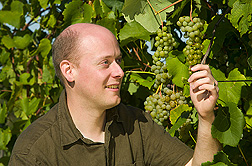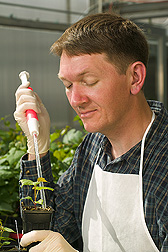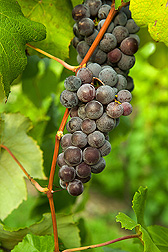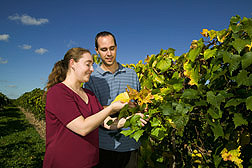In New York’s Finger Lakes Region
A Focus on Grape Genetics
ARS is breaking new ground in grape research in New York’s Finger Lakes region, whose storied history with viticulture and the wine industry dates back to the 1850s.
Scientists with ARS’s recently established Grape Genetics Research Unit (GGRU) in postcard-pretty Geneva, New York, study the full gamut of grapes grown in the United States, including those grown in California’s semiarid valleys and in northeastern states that experience cold winters.
The new unit works closely with ARS’s Plant Genetic Resources Unit (PGRU), which is also in Geneva and which is an integral part of the National Plant Germplasm System. PGRU preserves and safeguards about 20,000 samples of cold-hardy grapes, apples, tart cherries, and vegetables, and has more than 1,200 accessions of Vitis—about one-third of ARS’s total grape collection—planted in its vineyards.
“Our germplasm collection is an essential tool for GGRU’s genetics, genomics, and breeding research,” says PGRU fruit crops curator Philip Forsline. “In turn, findings by GGRU scientists increase the value of grape accessions in the collection.”
It’s in Geneva that plant geneticist Christopher Owens discovered something about the genetics that determine color, one of the most important grape characteristics.
The Keys to Color
|
|
“Color is a vital quality trait of table, juice, and wine grapes,” says Owens. “It’s even been linked to antioxidant content. But the genetics behind grape color is something that’s been poorly understood, until recently.”
Working with geneticist Patrice This of INRA—for Institut National de la Recherche Agronomique (The National Institute of Agricultural Research)—in Montpellier, France, Owens expanded on independent 2004 research in Japan that identified a genetic mutation known as Gret1 as responsible for white-skinned grapes.
That study showed that Gret1’s interaction with VvmybA1, a gene found in all V. vinifera grapes, was key to grapes’ turning out white. “Gret1 is a transposable element,” says Owens. “These are also known as ‘jumping genes’ because they are pieces of DNA that can move around within a genome.”
Owens says that grapes, being diploid organisms, have two copies of every gene. “When Gret1 is present in both copies of VvmybA1, the grapevine will bear white fruit.”
Owens examined far more cultivars—hundreds as opposed to about a dozen, he says—than the Japanese researchers did. In addition to verifying those findings, the Geneva group studied grape cultivars’ VvmybA1 genes for clues that hint at what promotes different-colored grapes.
|
|
Variations in the Gene
“We found that variations of this gene, spurred by mutation and movements of transposable elements, cause a large proportion of color variation in modern grape cultivars,” says Owens.
“In this case, when Gret1 ‘visits’ and then leaves, it slightly alters the surrounding DNA. These alterations then create additional variation in VvmybA1, which in turn can lead to variation in the grape’s fruit color.”
Owens says the finding is a potential milestone in grape research and production. “It grants us a better understanding of what genes determine the fruit color of a grape. It may help improve efficiency in breeding new grape cultivars for specific colors, as well as the intensity and color stability of juices and wines. It may also lead to a better understanding of how environment and management practices affect grape color and quality and of the relationships between fruit color and healthy compounds.”
Another possibility is to develop new cultivars with novel colors. “Picture it,” Owens says: “an orange grape!”
Other veins of grape research in Geneva entail protecting vines against threats such as aggressive nematodes and fungal diseases.
|
|
Fighting a Tougher Nematode
The past decade has seen emergence of aggressive root knot nematodes (Meloidogyne spp.) that overcome the natural defense mechanisms of grape rootstocks such as Freedom and Harmony, which are known for their resistance to these microscopic worms. “These nematodes have greatly affected California grape growers,” says plant geneticist Peter Cousins.
Cousins and his team have screened more than 10,000 grape rootstock seedlings for resistance to the tougher nematodes. “We select only those seedlings which completely suppress nematode feeding and reproduction and which show zero nematode egg masses,” he says. “Then we propagate them and plant them.”
The goal, he says, is to develop and introduce rootstocks that are both resistant to the tougher nematodes and adaptable to California viticulture. Seedlings grown in greenhouses at Geneva are screened with a technique he and University of California-Davis scientist Andy Walker developed that involves inoculating month-old seedlings with 1,500 young, aggressive root-knot nematodes.
So far, Cousins’ group has planted more than 200 resistant selections in the vineyard. They’ve also evaluated germplasm and found two accessions that tested completely resistant to aggressive strains.
A Different Gene Altogether
The team has also scored an important finding in work focusing on the gene in grapes—known as N—that allows them to resist Meloidogyne.
Specifically, the group studied an accession of V. mustangensis called DVIT1842 that fends off all root-knot nematodes, including the new aggressive strain.
Laurie Boyden, a Cornell University doctoral student working with Cousins, discovered that the gene conferring this accession’s resistance to nematodes was not a variation of the N gene, but a different gene altogether.
“There are now two known genes for root-knot nematode resistance in grapes, and it may be possible to breed both genes into the same rootstock—a technique known as ‘pyramiding,’” says Boyden. This strategy could provide better protection if the two genes act in different ways or if their interaction makes them more effective.
Foiling Fungal Pests
Meanwhile, fungi that can cause diseases and cripple grape production are the targets of work led by GGRU plant pathologist Lance Cadle-Davidson.
He has his sights set on thwarting Botrytis cinerea, which causes gray-mold disease, and Uncinula necator, the fungus that causes powdery mildew, through a better understanding of how plant development affects disease susceptibility.
Gray-mold disease, which on grapes is known as Botrytis bunch rot, affects most vegetable and fruit crops as well as many shrubs, trees, flowers, and weeds. Powdery mildew hampers vine growth and fruit yield and degrades fruit quality and a vine’s ability to survive the cold.
“For most of its interaction with grape berries, B. cinerea causes no damage to the developing fruit,” says Cadle-Davidson. “Then an unknown aspect of host development triggers the pathogen to activate from its quiescent state and destroy grape berries.”
He wants to show how and where B. cinerea survives within a grape berry, “to pinpoint when the pathogen activates and what genes are expressed in both host and fungus as they interact.”
Meanwhile, he’s approaching the control of the powdery mildew fungus by studying how and why resistance occurs at certain stages of host development—a feature known as “ontogenic resistance.”
Independent studies have shown that most cultivated grapes develop resistance to powdery mildew within 3 to 4 weeks of bloom. But, says Cadle-Davidson, “We’ve found that PGRU’s grape germplasm collection is rich with plants that have variations in this trait. If we can decipher the molecular basis of ontogenic resistance to U. necator, we plan to use the resistance in new disease-control strategies.”
Studying Aspects of Adaptation
Plant geneticist Amanda Garris is investigating grape genes that determine factors such as ripening, flowering, bud break, leaf fall, and dormancy. “In all plants, these are critical aspects of adaptation to an environment,” she says. “The developmental schedule is the result of interplay between the genome and the environment. With grapes in the United States, areas with warmer winters see uneven bud break that leads to uneven ripening later in the season. The Finger Lakes region’s short summers require grapes that ripen early.”
In one project, Garris and South Dakota State University researcher Anne Fennell are identifying genes involved in grapevines’ perception and response to the shorter day lengths of autumn.
“We’ve made some terrific findings recently,” says Cousins. “But we’re just getting started. We see ARS’s commitment to grape research in Geneva as a chance to accomplish great things.”
These high expectations are rooted in part in preliminary plans to build a new grape research facility in Geneva that will include laboratories and greenhouses.—By Luis Pons, Agricultural Research Service Information Staff.
This research is part of Plant, Microbial, and Insect Genetic Resources, Genomics, and Genetic Improvement (#301); Plant Biological and Molecular Processes (#302); Plant Diseases (#303); Crop Protection and Quarantine (#304); and Crop Production (#305), five ARS National Programs described on the World Wide Web at www.nps.ars.usda.gov.
Christopher Owens, Peter Cousins, Lance Cadle-Davidson, and Amanda Garris are in the USDA-ARS Grape Genetics Research Unit, 630 W. North St., Geneva, NY 14456; phone (315) 787-2244, fax (315) 787-2339.
"In New York's Finger Lakes Region—A Focus on Grape Genetics" was published in the April 2006 issue of Agricultural Research magazine.












